Limits
When a satelite is to be placed in orbit around the Earth, a multi-stage rocket engine is required. The reason for this is that as each stage burns out, it becomes advantageous to discard the weight of the remaining structure, thus decreasing the overall weight. When the aim is to escape Earth's gravity altogether, multi-stage design is not an option, but a necessity.
Ideally, if we could discard unnecessary weight constantly during the flight,
we would have less and less mass to push away from Earth's gravity. What this
means is that there would be as many stages as possible.
Theoretically, could we reach infinitely useful performance? To answer this
question, let's use the limit-finding capability of the TIs to find out what
happens when we design an infinite number of stages.

. Let's try to see what our TI thinks about it...

?
Umm... Why did my TI return an unsimplified
expression? 
Ans
Because you forgot a multiplcation sign beween the ![]() and the parenthesis in the denominator.
and the parenthesis in the denominator.
Don't forget that implied multiplication with the TI89 or 92+ is unnatural,
because it may assume you are refering to a function call, or that your variable's
name is ab
while you meant a·b or even a2 when
all you meant was a·2.
Now we can use the limit function to try to see what happens when
expr is the expression we are working with, here the variable un. var is the variable in expr which we want to approach point. The direction will be discussed later on.

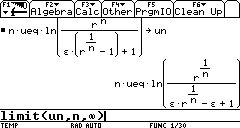

As surprising as it may seem, the result indicates that we cannot achieve
an infinite velocity, even if we designed an infinite number of stages.
As an example, a very good ![]() ratio that we can obtain using existing technology is about 6% (this means
that 6% of the entire rocket's mass is the structure). Also, for inter-planetary
satellites, it is necessary to completely escape Earth's gravity field, thus
un would be 11.2 km/s (36 700 ft/s). ueq, as a general rule
of thumb, is around 3 km/s (9 850 ft/s). With all this information, we can
deduce that at best, the ratio of rocket to satellite mass is:
ratio that we can obtain using existing technology is about 6% (this means
that 6% of the entire rocket's mass is the structure). Also, for inter-planetary
satellites, it is necessary to completely escape Earth's gravity field, thus
un would be 11.2 km/s (36 700 ft/s). ueq, as a general rule
of thumb, is around 3 km/s (9 850 ft/s). With all this information, we can
deduce that at best, the ratio of rocket to satellite mass is:
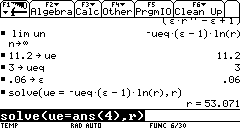
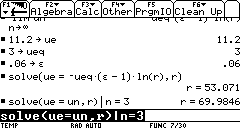
This problem is to determine whether a limit exists. The given expression:


Well, it seems our TI doesn't like it. Let's investigate this matter further. We know that a limit does not exist when the right-hand limit is not the same as the left-hand limit. Could this be what's troubling our TI?
To find a one-sided limit, we simply add a parameter to the function limit. This parameter comes last, and can be positive or negative.

For a right-hand direction, it suffices to take 1
(in fact, any other positive number will do).
For a left-hand direction, it suffices to take -1
(in fact any other negative number will do).
First we try the right-hand limit by adding the parameter 1 to the limit function:
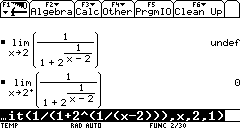


We can use the when function, to define f. The when function has the following syntax:
This is how we define our function on the TI:


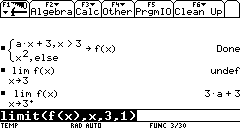
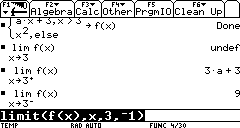
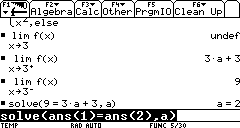
Congratulations! You have completed this task!
______________________________________________________________________________________
Created by Andrew Cacovean, March 8, 2002